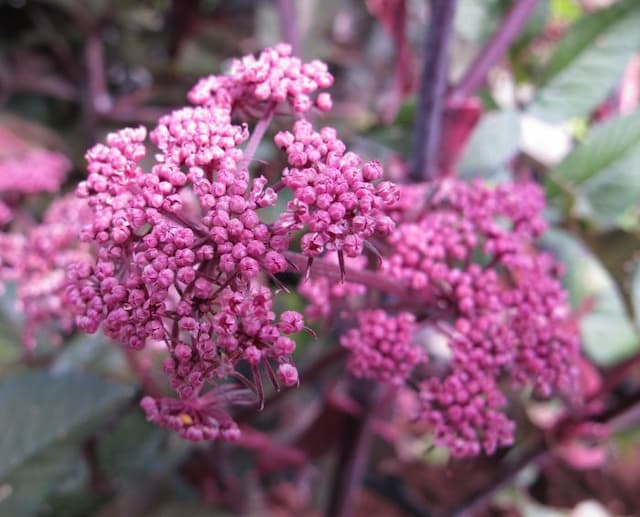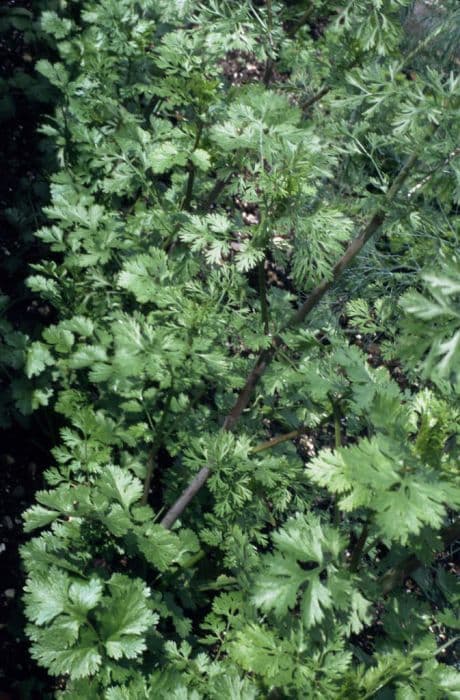Cow Parsley Anthriscus sylvestris

ABOUT
Anthriscus sylvestris, commonly known as cow parsley, is a plant that has a delicate and lacey appearance, primarily due to its feathery foliage. Its leaves are bright green, and they are divided multiple times into small, fine leaflets giving a fern-like appearance. These leaves grow from the plant’s base as well as along the stems, offering a fern-like or carrot top-like appearance. The plant is known for its umbels of small, white flowers that create a soft, somewhat foggy effect when seen en masse. These flower clusters sprawl out from the top of the stems, resembling a flat or slightly rounded canopy. Each individual flower is tiny and has a somewhat rounded petal arrangement, contributing to the overall fluffy, cloud-like appearance of the flower clusters. The stems of the cow parsley are sturdy but hollow and have vertical ridges. Beneath the plant, the root system typically consists of a taproot. The overall impression of the cow parsley is one of an airy, wispy plant that has a certain wild and untamed grace, often found along roadsides and in meadows where it sways gently with the wind, catching the light with its intricate leaves and soft flower umbels.
About this plant
 Names
NamesFamily
Apiaceae.
Synonyms
Cow Parsley, Wild Chervil, Wild Beaked Parsley, Keck, Queen Anne's Lace, Mother-Die, Wild Parsley, Adder's Meat.
Common names
Anthriscus nemorosa, Anthriscus sylvestris var. nemorosa, Anthriscus vulgaris, Selinum anthriscus, Chaerophyllum sylvestre, Cerefolium sylvestre, Myrrhis sylvestris.
 Toxicity
ToxicityTo humans
Cow Parsley has low toxicity to humans and is not considered poisonous. However, it can be easily confused with other highly poisonous plants, such as Hemlock (Conium maculatum). Therefore, it is crucial to correctly identify the plant before any ingestion. If Cow Parsley is mistaken for a toxic look-alike and ingested, the symptoms can vary but may include trembling, salivation, dilated pupils, muscle pain, rapid heart rate, digestive upset, and in severe cases, respiratory failure. These symptoms are not from Cow Parsley itself but from potential confusion with poisonous plants.
To pets
Cow Parsley is not generally considered highly toxic to pets, but as with humans, it can be confused with other similar-looking poisonous plants such as Hemlock. If a pet ingests a plant misidentified as Cow Parsley but which is actually a toxic species, they could exhibit symptoms including drooling, weakness, difficulty breathing, digestive upset, and seizures. Immediate veterinary attention would be necessary to treat the symptoms of poisoning from the toxic look-alike, not Cow Parsley itself.
 Characteristics
CharacteristicsLife cycle
Biennials
Foliage type
Deciduous
Color of leaves
Green
Flower color
White
Height
2-3 feet (0.6-0.9 meters)
Spread
1-2 feet (0.3-0.6 meters)
Plant type
Herb
Hardiness zones
5
Native area
Europe
Benefits
 General Benefits
General Benefits- Wildlife support: Cow parsley often serves as a food source and habitat for various insects, including beneficial pollinators such as bees and butterflies.
- Aesthetic appeal: With its delicate, white umbel flowers, cow parsley can add beauty and a wild, natural look to gardens and wildflower meadows.
- Erosion control: The plant's extensive root system can help stabilize soil and prevent erosion in certain environments.
- Companion planting: Cow parsley can be used in companion planting to encourage biodiversity and support the growth of other plants in the ecosystem.
- Edibility: Young leaves of cow parsley can be used in salads, while seeds can be used as a spice, offering a culinary use for foragers and those interested in edible wild plants.
- Cultural significance: Cow parsley has been part of folklore and traditional practices in various cultures, often used in seasonal festivals and customs.
- Soil improvement: The plant can contribute to soil health by adding organic matter and nutrients as it decomposes.
 Medical Properties
Medical Properties- Diuretic Effects - The leaves of cow parsley have been used traditionally to promote increased urine production.
- Emmenagogue - Historically, the plant was believed to stimulate menstrual flow.
- Carminative - The essential oils found in cow parsley may have been used to help reduce gas and bloating.
- Antiseptic Properties - Folk medicine practices used the plant's juices for their potential germ-killing abilities.
- Mild Analgesic - There are claims about cow parsley having pain-relieving effects.
 Air-purifying Qualities
Air-purifying QualitiesThis plant is not specifically known for air purifying qualities.
 Other Uses
Other Uses- As a natural dye: The roots of Cow parsley can be used to produce a natural dye for coloring fabrics, wool, or even Easter eggs, giving a beige or light brown hue.
- Insect repellent: The strong aromatic leaves of Cow parsley may be used to deter insects in natural pest control methods.
- As a companion plant: Cow parsley is said to be a good companion plant in gardens, potentially attracting beneficial insects or deterring pests from other plants.
- Indicator of soil quality: The presence of Cow parsley in the wild can indicate that the land is fertile and has good soil quality.
- Field boundary marker: Historically, Cow parsley has been used to mark field boundaries due to its rapid growth and distinctive appearance.
- Photography: Cow parsley, especially when in bloom with its white, umbrella-like flowers, is often used as a subject or backdrop in nature photography.
- Culinary garnish: Although not widely used, the delicate flowers of Cow parsley can be used as an edible garnish for salads or other dishes.
- Craft material: The dried stems and flowers of Cow parsley can be used in floral arrangements, wreaths, and other dry craft projects.
- Erosion control: The root system of Cow parsley can help keep soil in place, making it useful for preventing erosion in certain environments.
- Bioremediation agent: There is potential for Cow parsley to be used in bioremediation efforts to restore contaminated land due to its growth characteristics.
Interesting Facts
 Feng Shui
Feng ShuiThe Cow Parsley is not used in Feng Shui practice.
 Zodiac Sign Compitability
Zodiac Sign CompitabilityThe Cow Parsley is not used in astrology practice.
 Plant Symbolism
Plant Symbolism- Protection – Anthriscus sylvestris, also known as Cow Parsley, is often associated with protection due to its robust nature and the way it can quickly colonize an area, creating a sort of barrier or natural hedge.
- Fertility – The plant's vigorous growth and abundant seed production symbolize fertility and the capacity to promote abundant life.
- Humility – Cow Parsley is commonly found alongside roads, in fields, and in other humble places, which can represent modesty and the beauty found in unassuming locations.
- Purity – With its delicate white flowers that appear to be clean and pure, Cow Parsley often represents innocence and purity in certain contexts.
 Water
WaterCow Parsley prefers consistently moist soil, so it's important to water it regularly. Typically, watering once or twice a week should suffice, but this can vary depending on climate conditions. Each watering session should aim to provide enough water to moisten the soil to a depth of about an inch. During very hot or dry periods, increase the frequency to prevent the soil from drying out completely. If you're using gallons, about 1/2 to 1 gallon per week per plant is a good starting point, but be sure to adjust based on rainfall and temperature changes.
 Light
LightCow Parsley, also known as Wild Chervil, thrives best in partial shade to full sun. It grows well in dappled sunlight beneath the canopy of trees, where it receives filtered light. However, it can also adapt to areas that receive direct sunlight for several hours each day. Avoid placing it in deep shade, as this can reduce its vigor and flowering potential.
 Temperature
TemperatureCow Parsley is well-suited to a temperature range typically found in temperate regions. It can survive in temperatures as low as 20°F but is more comfortable in a range between 50°F and 70°F, which encourages active growth and flowering. During the hot summer months, Cow Parsley can withstand temperatures up to around 80°F. Sudden, extreme shifts in temperature should be avoided to prevent stress to the plant.
 Pruning
PruningPruning Cow Parsley is mainly for aesthetic purposes and to prevent self-seeding if not desired. Cut back the flowering stems after blooming if you wish to avoid spreading. The best time for general pruning is in late autumn or early winter after the plant has died back, which will help keep the area tidy and may encourage bushier growth next season. Prune as needed, generally once a year.
 Cleaning
CleaningAs needed
 Soil
SoilCow parsley thrives in a well-draining soil mix rich in organic matter with a pH range from 5.5 to 7.5. Incorporate compost or aged manure to enrich the soil and ensure good fertility levels for optimal growth.
 Repotting
RepottingCow parsley, being a herbaceous perennial, does not typically require repotting. It is generally sown directly where it is to grow and does not need to be moved.
 Humidity & Misting
Humidity & MistingCow parsley prefers moderate ambient humidity, typical of outdoor environments. It does not have specific high humidity requirements and can tolerate natural fluctuations.
 Suitable locations
Suitable locationsIndoor
Place cow parsley in bright, indirect light and keep soil moist.
Outdoor
Sow in partial shade to full sun, in fertile, moist soil.
Hardiness zone
5-9 USDA
 Life cycle
Life cycleCow parsley, or Anthriscus sylvestris, begins its life cycle as a seed that germinates in early spring when soil temperatures warm. After germination, the seedlings develop into rosettes with leaves spreading out close to the ground. In its second year, the plant bolts, sending up tall, hollow stems and branching out to form its characteristic umbels of white, lacy flowers which usually bloom from April to June. Following pollination, typically by a range of insects, the flowers develop into small, bristly fruits that disperse to form new plants. Cow parsley is a biennial plant, meaning it completes its life cycle in two years—after setting seed, the mature plant dies. However, this plant can also behave as a short-lived perennial in some conditions, persisting through vegetative reproduction.
 Propogation
PropogationPropogation time
Spring-Early Summer
Anthriscus sylvestris, commonly known as cow parsley, is typically propagated through seed. The best time for sowing these seeds is either in the fall or early spring. When propagating cow parsley by seed, first, you should collect the seeds once they mature on the plant which usually happens by late summer. After collecting the seeds, they can either be sown directly into the ground where they are to grow, or they can be started in seed trays or pots. If starting the seeds in trays or pots, use a well-draining soil mix and lightly cover the seeds with soil. They require a position in either full sun or partial shade, in soil that is well drained yet retains moisture. Seeds should germinate in approximately two to three weeks, and once established, the seedlings can be transplanted to their final growing positions, ensuring they are spaced about 12 inches (roughly 30 centimeters) apart to allow for their full growth potential.








